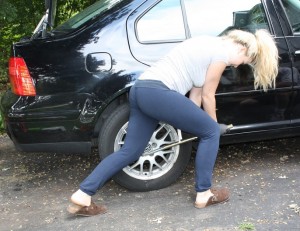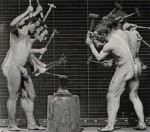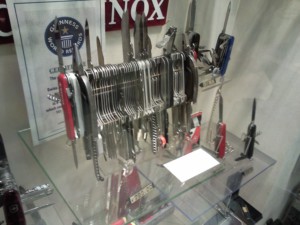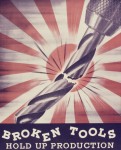One popular and well-known concept of the Toyota Production System is the elimination of waste, in Japanese also called muda (無駄). It is one of the three evils of manufacturing systems, the others being unevenness (mura, 斑) and overburden (muri, 無理). In this post I would like to go through the details of waste with you. This includes the traditional seven types of waste – of which I am a big fan. For completeness sake I also included a lot more types of waste I have come across in industry. However, you have to decide yourself if these additional wastes are not themselves a waste.
A Quick History of Waste

The idea to reduce waste, create order, and treat your workers humanely is not new. Reducing waste is probably the most obvious one, and has been around as long as there was manufacturing. For example, Benjamin Franklin clearly realized the waste of excessive inventory:
You call them goods; but, if you do not take care, they will prove evils to some of you. You expect they will be sold cheap, and, perhaps, they may [be bought] for less than they cost; but, if you have no occasion for them, they must be dear to you. Remember what Poor Richard says, 'Buy what thou hast no need of, and ere long thou shalt sell thy necessaries.' (Benjamin Franklin, The Way to Wealth, 1758)
Taylor and Gilbreth also focused intensely on waste reduction through detailed analysis of motions. Also, Ford already had waste walks long before Toyota. Hence, eliminating waste is nothing new. It is through the popularity of the Toyota Production System, and by proxy, lean manufacturing, that it is mostly associated with Toyota. Nevertheless, it is one of the important concepts of the Toyota Production System, along with unevenness (mura) and overburden (muri).
In the Western world, waste is much better known than unevenness and overburden, and therefore it gets more prominence, often resulting in neglect of the other two evils. In any case, let’s go into more detail about waste:
What is Waste (Muda)?
Muda (無駄): futility; uselessness; pointlessness; waste;
Everything that is done in the company is divided into two groups: value-adding and waste. Generally speaking, value-adding is anything the customer pays for, and waste is anything the customer does not care about. Sounds easy, right? In practice, however, it is a bit more difficult, and there is a large gray zone.

Assume that you are attaching a wheel to a car. Of course, the customer wants his car to have wheels. He would pay less for a car without wheels attached (well, I would!). Therefore, attaching the wheels and screwing on the bolts is value-adding.
Or is it? You could also say that the customer does not care about screwing on the bolts, as long as they are tightened. Hence, with equal validity you could say that only the last quarter turn tightening the bolts are value=adding, and all turns before are waste. Therefore, if you have a screw that needs less turns to hold the wheel securely, you would have reduced waste. Both views are equally valid.
As for transport, the wheels were probably not produced at the same spot where they are installed. Instead, a transport process brought them to the assembly site. The customer does not care if you carry around your wheels, hence it is waste. Yet, it is probably not possible to eliminate transport completely. Hence, in industry it is often differentiated between avoidable waste (that can be eliminated completely) and unavoidable waste (that can be reduced but not eliminated). Of course, like value-adding and waste, avoidable and unavoidable waste also have a big gray zone in between.
The Seven Types of Waste
 In particular for manufacturing, Toyota has defined seven types of waste in more detail.
In particular for manufacturing, Toyota has defined seven types of waste in more detail.
Transportation
 Any type of transportation is waste. The less you transport, the better. Not only does it cost time and money, it can also cause damage or you can misplace the item completely.
Any type of transportation is waste. The less you transport, the better. Not only does it cost time and money, it can also cause damage or you can misplace the item completely.
Movement

Avoid unnecessary movements. Arrange everything so the worker has to move as little as necessary to assemble the product. MTM and REFA are strong methods in this aspect (see also Taylor and Gilbreth). This applies not only to workers, but also to machines, albeit the workers are more important. In a machine, do not move the tool 10 inches out of the way if 5 inches will suffice. The machine will be faster, and there will be less wear and tear.
Waiting

This refers primarily to people waiting. Not quite as important but also included are machines waiting. Not included are parts waiting, since this would be included in the waste through inventory (even though Wikipedia says differently at the time of me writing this post). For people it is easy to see. You are paying them wages, yet if they have to wait for parts, machine processes, or other workers, this money is wasted. Crucially, Toyota also considers this disrespectful to the people.
This is also the main reason why waiting times for machines are considered less important. If you have the choice, you should rather let the machine wait for the operator than the operator for the machine. (OEE is a good measure here and can also help you to improve your utilization, as long as you don’t fudge the numbers.) Hence, machine utilization and OEE is NOT a type of waste!
Of course, if you can increase both, it would be best – given that you actually need the products. Unfortunately, I have seen too many examples where management wanted to increase utilization of machines and merely ended up with lots of not (yet) needed inventory – leading to an even bigger waste of overproduction and inventory.
Over-Processing

Over-processing refers to inclusion of additional features, parts, processes, or other things that the customer does not need and hence is not willing to pay for. This is the proverbial golden screw. It sounds obvious not to include features the customer does not want, but unfortunately it is not so.
Products are purchased by the customer but designed by the designers and engineers. Unfortunately, these have a completely different mindset, and may be aware of potential flaws and possible features that the customer has never ever heard of before. This is particularly common in industries where the designers and engineers are particularly attached to their product (e.g., the automotive industry or machine tool building), although pretty much any product is loved by at least some of their creators.
I have seen many products being over-designed and over-engineered to include features that 99% of the customers did not care about or did not even know about, yet the designers wanted their baby to be perfect. Yet, if it adds no value for the customer, it is a waste. See, for example, my Lean Obituary for Maybach, which was primarily built for the Daimler executives (although they did not pay for them themselves) and ended up losing half a million dollar per vehicle.
Defects and Rework

Any product that does not satisfy the requirements and has to be reworked or thrown out. This is also an obvious and expensive type of waste. Similar to overproduction, you invested all the capacity, material, and time, but then you cannot even sell the product but have to throw it out.
Even if it can be reworked, it is an additional effort, will consume more capacity and time, and in general will mess up your production schedule. Hence, when you do it, do it right the first time.
Inventory

Any kind of material you have but do not work on right now is a waste. You paid for it, but it merely sits around, has to be maintained, transported, and uses up space. Inventory can easily cost you 30%–65% of its value per year. For details, see my post The Hidden and Not-So-Hidden Costs of Inventory.
Yet, in many firms, inventory is still seen as something good, especially on the shop floor. Inventory gives security. You always have something to work on, and you are more likely to have something to sell if the customer comes around. Yet, while you need inventory, it makes you sluggish and expensive.
Over-Production
Producing more than what is needed is a waste. Lean production is lean especially because it produces only what is needed. Overproduction ties up capacity, material, time, and other resources that are not yet needed. In effect you are paying today what you may have to pay only a week from now. Additionally, you now have even more inventory, and hence you are losing even more money.
In a traditional view, overproduction is the worst waste of all the seven types of waste. Overproduction will act as a multiplier to many other types of waste. It will (naturally) increase inventory, and also transportation and movement. Furthermore, defects may be noticed too late. Hence, try to avoid it if you can.
Many More Additional Wastes – What a Waste!
The idea of eliminating waste is a very easy-to-understand concept. Hence, it is no surprise that many people added additional types of waste to the classical seven types of waste above. Personally, I am a big fan of the above seven, and not so much of the others below. For me, all too often these additional wastes are difficult to measure, add little value, are too detailed, overlapping, and may be even a waste themselves by being an excessive list of possible wastes. Some are from Six Sigma, others from TPM (Total Productive Maintenance, which has 16! types of waste), and other sources in literature. :In any case, see for yourself if any of the list below suits you, it mostly does not for me:
- Unused (Floor) Space: Also a waste. At least one company I know generated this due to their hierarchy structure. Design and Manufacturing were separate entities, hence Manufacturing was not in charge of “over-processing” above. In order for them to still have seven types of waste, floor space was added. As far as waste goes, the idea is not bad, and less unused floor space is better.
- Manufacturing goods or services that do not meet customer demand or specifications: Added by Womack, also a possible candidate to consider
- Unused Human Creativity/Potential; also known as Knowledge Disconnection: This one seems to be popular with Six Sigma, and is also the most commonly found additional waste. Of course, wasting human creativity is not good. However, my problem with this type of waste is, how do you measure it? Everything above can be measured somehow, but how do you measure human creativity? In any case, while it is not part of the traditional seven types of waste, Toyota is pretty good at using this creativity.
- Confusion: Clearly wasteful, but also difficult to measure. In my view this is probably not a waste, but the result of other wastes. In any case, the less confusion, the better.
- Unsafe Working Conditions: Work environments that are not safe are of course a big potential source of trouble. For me, this could also be included in overburden (muri), but could also stand on its own.
- Wasted Opportunity: True, but how do you measure it?
- Wasted Time in Meetings: Also true, but way too detailed for my taste.
- Time wasted chasing fads: Way too detailed, even if you would know how to measure it. This waste may even be an ironic type of waste, as it could be its own fad …
- Sub-Optimization: Not optimizing everything as much as you can. Well … yes … but wouldn’t that result in one or more of the seven types of waste above?
- Ignoring Lessons of History: … right next to the waste of not being able to read and do math …
- Equipment failure: For me included in the seven traditional types of waste, depending on its effects as waiting, movement, or defects.
- Change Overs: also included in the seven traditional types of waste
- Tool Change: Same as above, way too detailed
- Ramp Up Losses: More of the same
- Short time Stops and small breakdowns: Small stops and breakdowns. This one comes probably from one of the three loss categories in the OEE
- Speed Losses: The system runs slower than it could – Probably another one from OEE
- Planned Stops: Probably another one from OEE
- Management Losses: This includes any failure of management. This could be huge, but TPM (where it came from) narrows it down quite a bit to lack of material or instructions and overproduction due to management failures.
- Line Organization Losses: This is to represent badly set up production lines. As far as wastes go, this is for me now only an example, and no longer a type of waste. At the same time the original definition from TPM did not even consider that not every production is a line, but there are also for example job shops and on site manufacturing.
- Logistic Losses: Manufacturing stops due to loading and unloading.
- Measuring and Adjusting Losses: Manufacturing stops due to measuring and adjusting. Also overkill in my view.
- Usage Losses: The materials used in production are not used efficiently. Examples are too sturdy products (which would be over-processing) or too much scrap.
- Energy Losses: Wasting of Energy of any type. May even make some sense, also feeds in the current green and Eco trend in industry.
- Forms, Dies, and Tool Losses: Losses due to design changes that require a tool change. Kind of true, but again way too much detailed.
Conclusion
Overall, knowing, identifying, and especially reducing the seven (or more) types of waste can give your production system a big advantage. Waste walks to identify sources of waste are also common in industry, although it is easy to find more waste than what the improvement system can handle. It is, for example, easy to see missing parts leading to the waste of waiting. Fixing them, however, is much more difficult. In any case, do not get lost with an excessive list of ill-structured types of waste. In case of doubt, stick to the original seven types of waste.
Additionally, do not neglect the other two evils, unevenness (mura) and overburden (muri). They also have a significant negative effect on your manufacturing system. Now go out, eliminate waste, and Organize your Industry!


This article also got mentioned on What can dev teams learn from manufacturing? on the Dysfunctional Requirements blog.
usefull
Can you recommend me some courses to improve in this topic better?
Hi Eva, there should be lots of lean trainings available wherever you are located, although I cannot say anything about the quality of these trainings and hence have no recommendations (outside of Germany).
What are the 7 pages of muda?
Hixperience
All thesedays from 1980 I was specialized in Lean & Lean six sigma has a
Professor & CEO having 50 years of experience in industry
You article educated me more
THANK YOU & GOD BLESS YOU
Regards
Prof. Rammohun
Hi Rammohun, quite a compliment. Thank you and keep on reading 🙂
Hi Christoph, nice read, especially with all the extra wastes….we compiled a list of 8 wastes and how to eliminate with wearable devices: https://workerbase.com/
Hello,
Found this blog this week because we were tasked to find a lean blog about the 8 wastes. I know yours is about the 7 wastes outlined by Toyota. You certain outline all 8 if you look through the 24 additional wastes Un-used employee potential is in there.
This week I have been jotting down all the wastes I see at my Office job. It is remarkable how poor things are run and how much waste is created!
The simplest example. We have the capability to all work 100% remote. the day before a big winter storm Upper management waits to the last moment to make an announcement on what is expected the next day. Meanwhile the Hens in the office are not focusing on their work and are just talking about what will happen on a Snow Day. If there was a procedure in place given the bad weather forecast we all would have an answer much sooner and waste much less time speculating !
A silly example but the productivity the day before a storm is far to low for me. This is 100% based on observation. I do not have concrete research.
Thank you!
This article also got mentioned as additional resource on the 7 Wastes in “What are the 7 Wastes in Lean” by Lean Enterprise Institute. https://www.lean.org/lexicon-terms/seven-wastes/